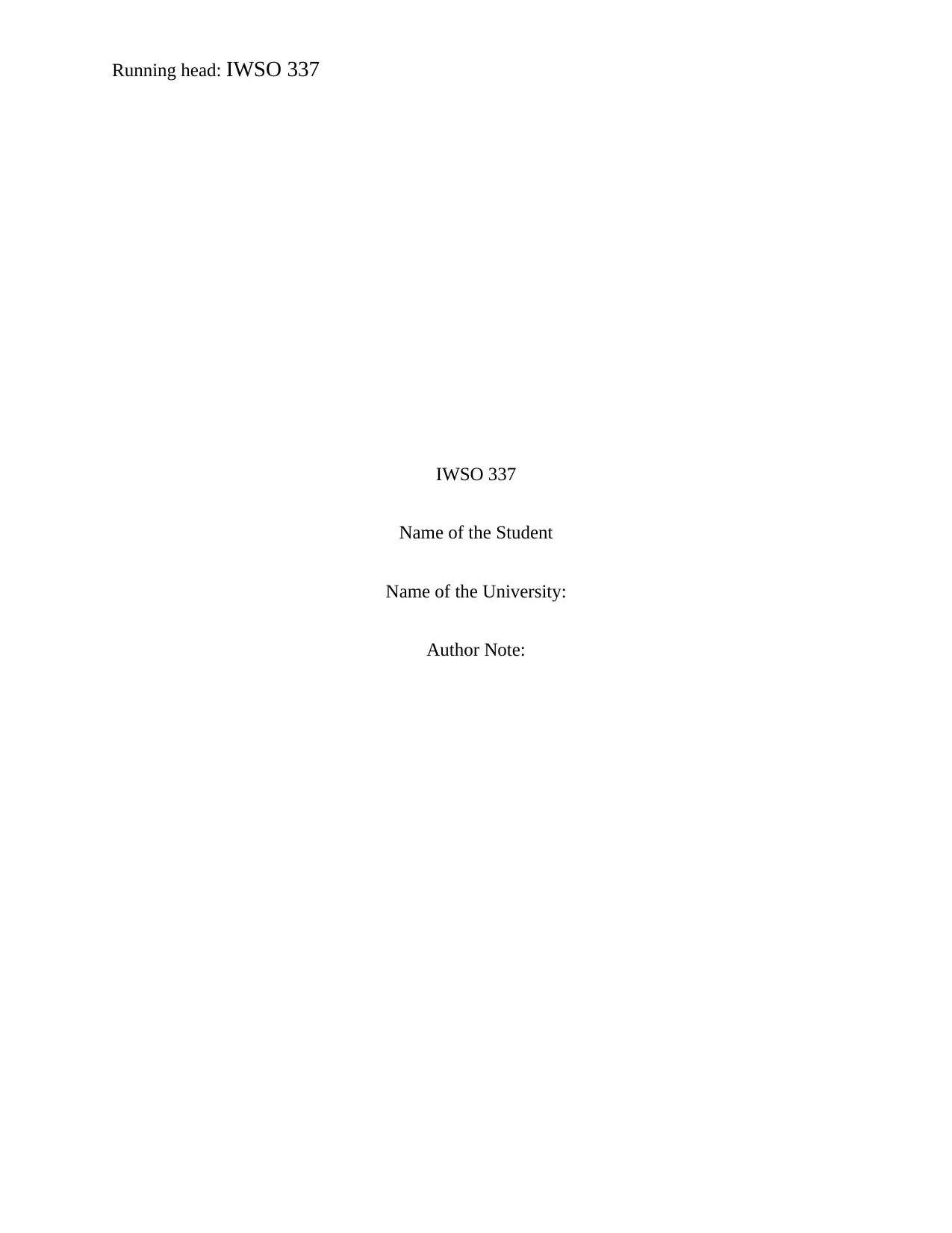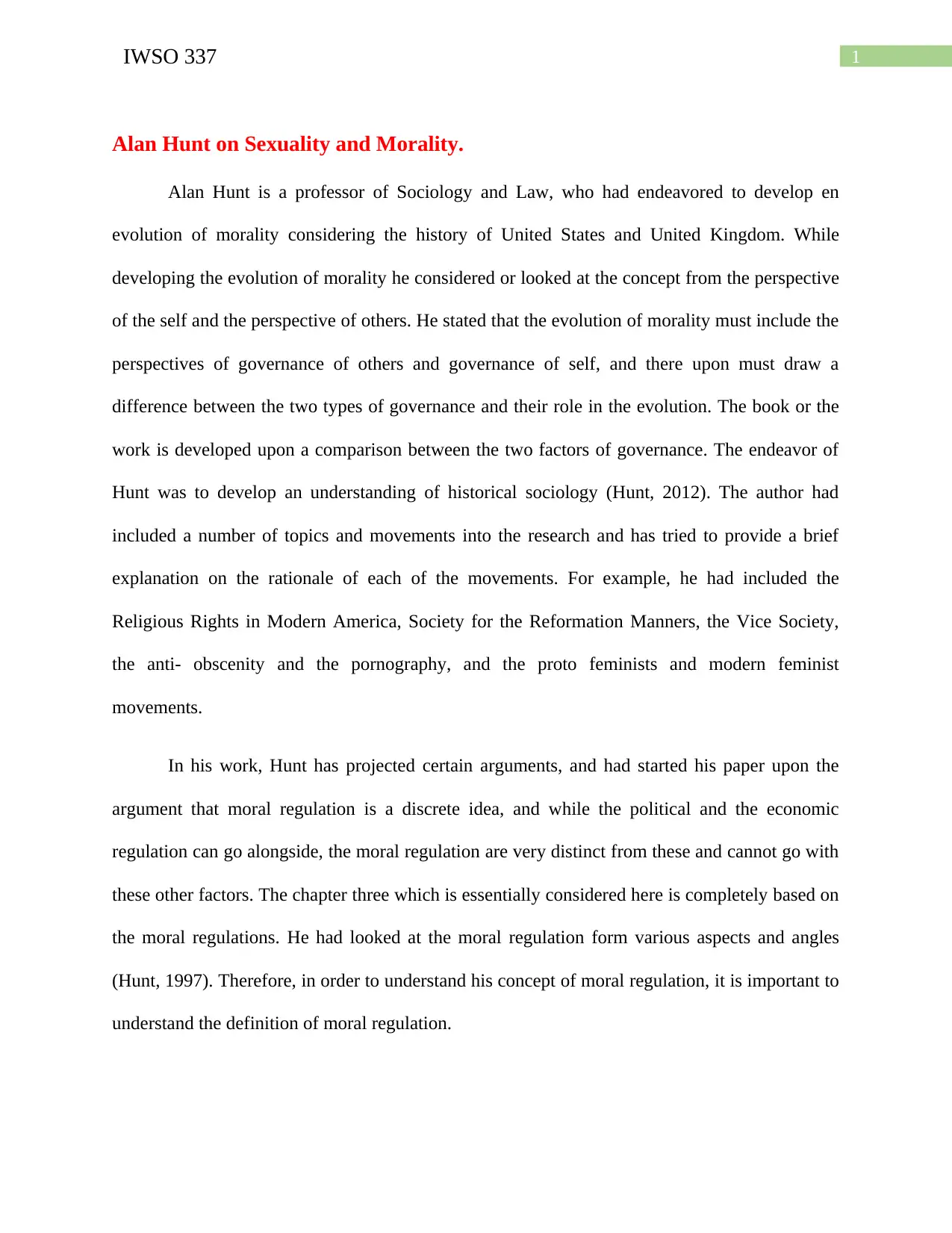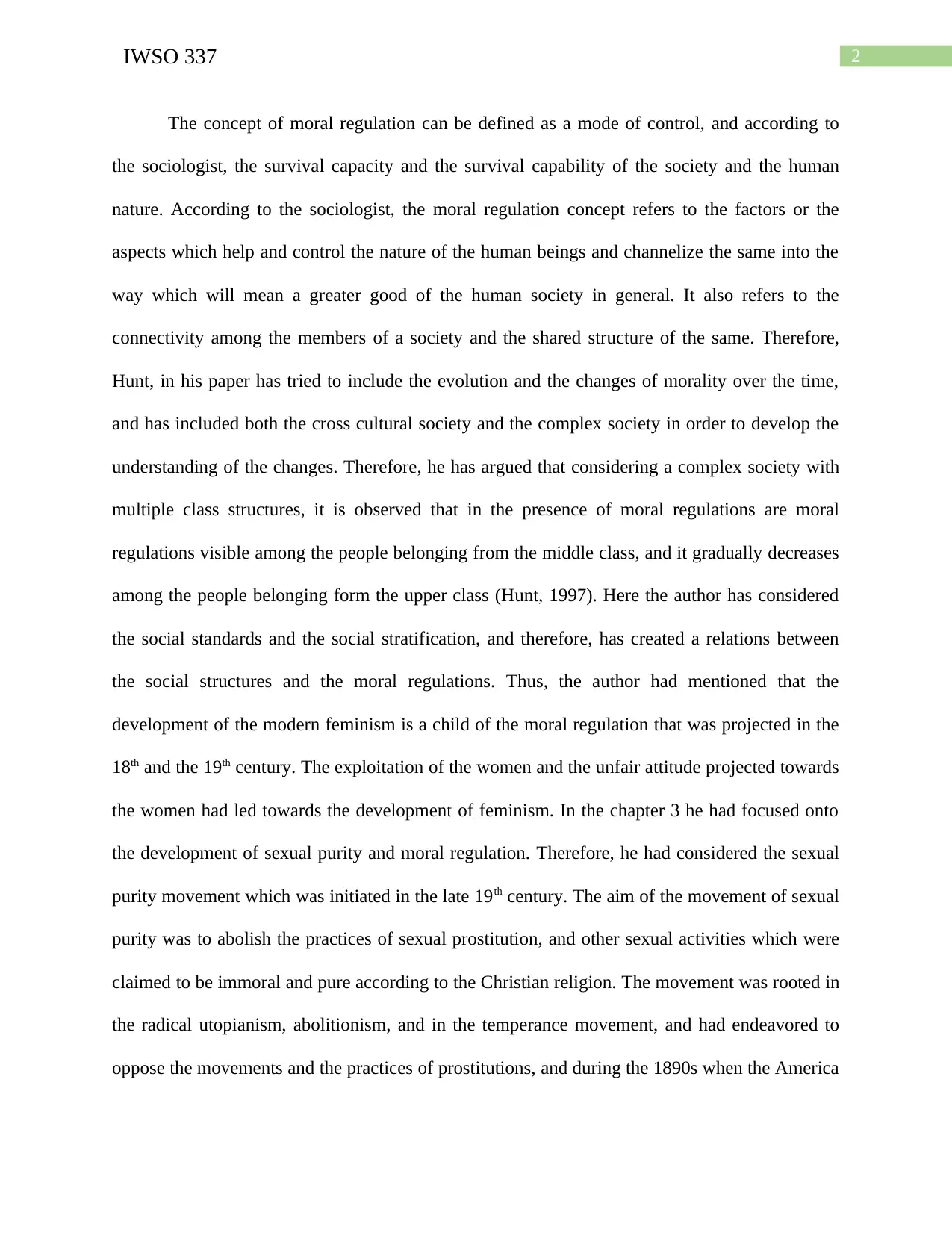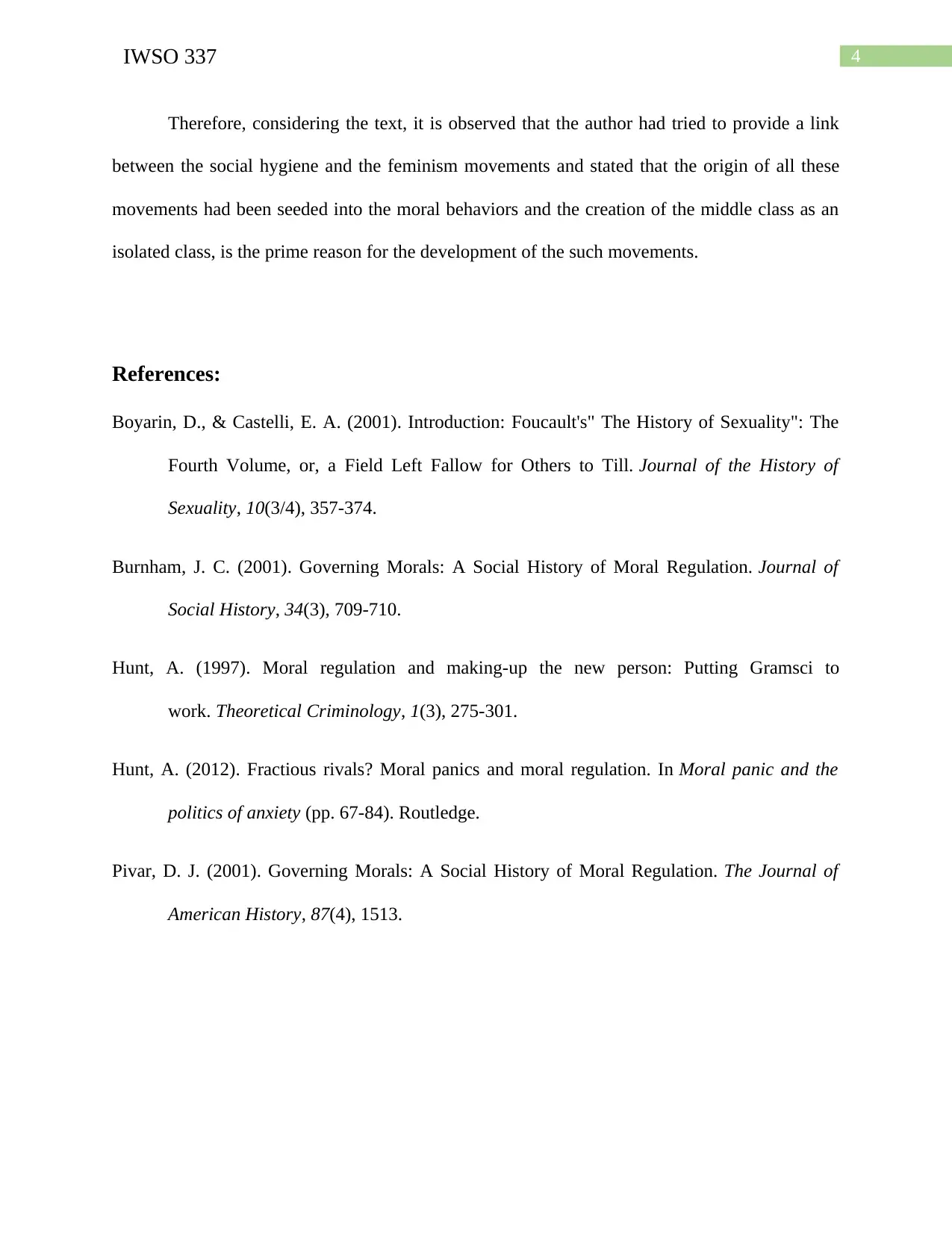IWSO 337 Report: Alan Hunt's Perspective on Sexuality and Morality
VerifiedAdded on 2022/08/12
|5
|1319
|15
Report
AI Summary
This report analyzes Alan Hunt's exploration of moral regulation, focusing on his perspective on sexuality and its evolution within society. The report delves into Hunt's arguments about the distinct nature of moral regulation compared to political and economic regulations, emphasizing its role in shaping societal norms and behaviors. It examines Hunt's historical analysis, including the influence of movements such as religious rights, feminism, and social hygiene. The report highlights Hunt's view on the relationship between social class, moral standards, and the development of social movements, particularly the connection between middle-class women and the critique of prostitution. Furthermore, it discusses Hunt's linkage of social hygiene and feminism, positing that moral behaviors and the creation of a distinct middle class were central to the emergence of these movements. The report draws on Hunt's insights to understand power dynamics, governance, and the impact of societal structures on individual behaviors and social change, drawing on concepts of delinquency and dividing practices influenced by Joan Sangster.

Running head: IWSO 337
IWSO 337
Name of the Student
Name of the University:
Author Note:
IWSO 337
Name of the Student
Name of the University:
Author Note:
Paraphrase This Document
Need a fresh take? Get an instant paraphrase of this document with our AI Paraphraser

1IWSO 337
Alan Hunt on Sexuality and Morality.
Alan Hunt is a professor of Sociology and Law, who had endeavored to develop en
evolution of morality considering the history of United States and United Kingdom. While
developing the evolution of morality he considered or looked at the concept from the perspective
of the self and the perspective of others. He stated that the evolution of morality must include the
perspectives of governance of others and governance of self, and there upon must draw a
difference between the two types of governance and their role in the evolution. The book or the
work is developed upon a comparison between the two factors of governance. The endeavor of
Hunt was to develop an understanding of historical sociology (Hunt, 2012). The author had
included a number of topics and movements into the research and has tried to provide a brief
explanation on the rationale of each of the movements. For example, he had included the
Religious Rights in Modern America, Society for the Reformation Manners, the Vice Society,
the anti- obscenity and the pornography, and the proto feminists and modern feminist
movements.
In his work, Hunt has projected certain arguments, and had started his paper upon the
argument that moral regulation is a discrete idea, and while the political and the economic
regulation can go alongside, the moral regulation are very distinct from these and cannot go with
these other factors. The chapter three which is essentially considered here is completely based on
the moral regulations. He had looked at the moral regulation form various aspects and angles
(Hunt, 1997). Therefore, in order to understand his concept of moral regulation, it is important to
understand the definition of moral regulation.
Alan Hunt on Sexuality and Morality.
Alan Hunt is a professor of Sociology and Law, who had endeavored to develop en
evolution of morality considering the history of United States and United Kingdom. While
developing the evolution of morality he considered or looked at the concept from the perspective
of the self and the perspective of others. He stated that the evolution of morality must include the
perspectives of governance of others and governance of self, and there upon must draw a
difference between the two types of governance and their role in the evolution. The book or the
work is developed upon a comparison between the two factors of governance. The endeavor of
Hunt was to develop an understanding of historical sociology (Hunt, 2012). The author had
included a number of topics and movements into the research and has tried to provide a brief
explanation on the rationale of each of the movements. For example, he had included the
Religious Rights in Modern America, Society for the Reformation Manners, the Vice Society,
the anti- obscenity and the pornography, and the proto feminists and modern feminist
movements.
In his work, Hunt has projected certain arguments, and had started his paper upon the
argument that moral regulation is a discrete idea, and while the political and the economic
regulation can go alongside, the moral regulation are very distinct from these and cannot go with
these other factors. The chapter three which is essentially considered here is completely based on
the moral regulations. He had looked at the moral regulation form various aspects and angles
(Hunt, 1997). Therefore, in order to understand his concept of moral regulation, it is important to
understand the definition of moral regulation.

2IWSO 337
The concept of moral regulation can be defined as a mode of control, and according to
the sociologist, the survival capacity and the survival capability of the society and the human
nature. According to the sociologist, the moral regulation concept refers to the factors or the
aspects which help and control the nature of the human beings and channelize the same into the
way which will mean a greater good of the human society in general. It also refers to the
connectivity among the members of a society and the shared structure of the same. Therefore,
Hunt, in his paper has tried to include the evolution and the changes of morality over the time,
and has included both the cross cultural society and the complex society in order to develop the
understanding of the changes. Therefore, he has argued that considering a complex society with
multiple class structures, it is observed that in the presence of moral regulations are moral
regulations visible among the people belonging from the middle class, and it gradually decreases
among the people belonging form the upper class (Hunt, 1997). Here the author has considered
the social standards and the social stratification, and therefore, has created a relations between
the social structures and the moral regulations. Thus, the author had mentioned that the
development of the modern feminism is a child of the moral regulation that was projected in the
18th and the 19th century. The exploitation of the women and the unfair attitude projected towards
the women had led towards the development of feminism. In the chapter 3 he had focused onto
the development of sexual purity and moral regulation. Therefore, he had considered the sexual
purity movement which was initiated in the late 19th century. The aim of the movement of sexual
purity was to abolish the practices of sexual prostitution, and other sexual activities which were
claimed to be immoral and pure according to the Christian religion. The movement was rooted in
the radical utopianism, abolitionism, and in the temperance movement, and had endeavored to
oppose the movements and the practices of prostitutions, and during the 1890s when the America
The concept of moral regulation can be defined as a mode of control, and according to
the sociologist, the survival capacity and the survival capability of the society and the human
nature. According to the sociologist, the moral regulation concept refers to the factors or the
aspects which help and control the nature of the human beings and channelize the same into the
way which will mean a greater good of the human society in general. It also refers to the
connectivity among the members of a society and the shared structure of the same. Therefore,
Hunt, in his paper has tried to include the evolution and the changes of morality over the time,
and has included both the cross cultural society and the complex society in order to develop the
understanding of the changes. Therefore, he has argued that considering a complex society with
multiple class structures, it is observed that in the presence of moral regulations are moral
regulations visible among the people belonging from the middle class, and it gradually decreases
among the people belonging form the upper class (Hunt, 1997). Here the author has considered
the social standards and the social stratification, and therefore, has created a relations between
the social structures and the moral regulations. Thus, the author had mentioned that the
development of the modern feminism is a child of the moral regulation that was projected in the
18th and the 19th century. The exploitation of the women and the unfair attitude projected towards
the women had led towards the development of feminism. In the chapter 3 he had focused onto
the development of sexual purity and moral regulation. Therefore, he had considered the sexual
purity movement which was initiated in the late 19th century. The aim of the movement of sexual
purity was to abolish the practices of sexual prostitution, and other sexual activities which were
claimed to be immoral and pure according to the Christian religion. The movement was rooted in
the radical utopianism, abolitionism, and in the temperance movement, and had endeavored to
oppose the movements and the practices of prostitutions, and during the 1890s when the America
⊘ This is a preview!⊘
Do you want full access?
Subscribe today to unlock all pages.

Trusted by 1+ million students worldwide

3IWSO 337
decided to legalize the practices of prostitution, the movement had gained a shape and size
(Pivar, 2001). Along with the opposition of legalization of prostitution, the movement voiced
against age of consent, contraception, and the white slavery through censoring the pornography.
According to Hunt, all these attributes are related to the practices and the concepts of
moral regulation. The mentioned movement was a sect of the Feminism movements, and
according to the author, the need and the position of women was realized and the importance of
the role of the women in the society and in the progression of the same was also realized.
Furthermore, the author had created a relation between the social hygiene movement and
the sexual movements. He stated that the processes of urbanization and the class consciousness,
and the immigration policies all had contributed in the development of the conceit and the
movement against the social hygiene. The author had also showed that the World War I had a
huge impact upon the development of the social hygiene movement (Burnham, 2001). The
author stated theta it is the morality and the moral understanding that had contributed in the
developments of the movements, however since the position of the factors of the social hygiene
was not strong enough, therefore, it had to be intersected with something else, and hence it was
associated with the feminism movements and factors of social purity had provided the link
between the factors of feminism movements and the social hygiene movements. He further
mentioned that it was the middle class women who had first identified the practice of prostitution
to be illegal and immoral (Boyarin, & Castelli, 2001). At the same time, he found that it is
because of the presence of the middle class, the stark difference in the social hygiene had
become a major issue.
decided to legalize the practices of prostitution, the movement had gained a shape and size
(Pivar, 2001). Along with the opposition of legalization of prostitution, the movement voiced
against age of consent, contraception, and the white slavery through censoring the pornography.
According to Hunt, all these attributes are related to the practices and the concepts of
moral regulation. The mentioned movement was a sect of the Feminism movements, and
according to the author, the need and the position of women was realized and the importance of
the role of the women in the society and in the progression of the same was also realized.
Furthermore, the author had created a relation between the social hygiene movement and
the sexual movements. He stated that the processes of urbanization and the class consciousness,
and the immigration policies all had contributed in the development of the conceit and the
movement against the social hygiene. The author had also showed that the World War I had a
huge impact upon the development of the social hygiene movement (Burnham, 2001). The
author stated theta it is the morality and the moral understanding that had contributed in the
developments of the movements, however since the position of the factors of the social hygiene
was not strong enough, therefore, it had to be intersected with something else, and hence it was
associated with the feminism movements and factors of social purity had provided the link
between the factors of feminism movements and the social hygiene movements. He further
mentioned that it was the middle class women who had first identified the practice of prostitution
to be illegal and immoral (Boyarin, & Castelli, 2001). At the same time, he found that it is
because of the presence of the middle class, the stark difference in the social hygiene had
become a major issue.
Paraphrase This Document
Need a fresh take? Get an instant paraphrase of this document with our AI Paraphraser

4IWSO 337
Therefore, considering the text, it is observed that the author had tried to provide a link
between the social hygiene and the feminism movements and stated that the origin of all these
movements had been seeded into the moral behaviors and the creation of the middle class as an
isolated class, is the prime reason for the development of the such movements.
References:
Boyarin, D., & Castelli, E. A. (2001). Introduction: Foucault's" The History of Sexuality": The
Fourth Volume, or, a Field Left Fallow for Others to Till. Journal of the History of
Sexuality, 10(3/4), 357-374.
Burnham, J. C. (2001). Governing Morals: A Social History of Moral Regulation. Journal of
Social History, 34(3), 709-710.
Hunt, A. (1997). Moral regulation and making-up the new person: Putting Gramsci to
work. Theoretical Criminology, 1(3), 275-301.
Hunt, A. (2012). Fractious rivals? Moral panics and moral regulation. In Moral panic and the
politics of anxiety (pp. 67-84). Routledge.
Pivar, D. J. (2001). Governing Morals: A Social History of Moral Regulation. The Journal of
American History, 87(4), 1513.
Therefore, considering the text, it is observed that the author had tried to provide a link
between the social hygiene and the feminism movements and stated that the origin of all these
movements had been seeded into the moral behaviors and the creation of the middle class as an
isolated class, is the prime reason for the development of the such movements.
References:
Boyarin, D., & Castelli, E. A. (2001). Introduction: Foucault's" The History of Sexuality": The
Fourth Volume, or, a Field Left Fallow for Others to Till. Journal of the History of
Sexuality, 10(3/4), 357-374.
Burnham, J. C. (2001). Governing Morals: A Social History of Moral Regulation. Journal of
Social History, 34(3), 709-710.
Hunt, A. (1997). Moral regulation and making-up the new person: Putting Gramsci to
work. Theoretical Criminology, 1(3), 275-301.
Hunt, A. (2012). Fractious rivals? Moral panics and moral regulation. In Moral panic and the
politics of anxiety (pp. 67-84). Routledge.
Pivar, D. J. (2001). Governing Morals: A Social History of Moral Regulation. The Journal of
American History, 87(4), 1513.
1 out of 5
Related Documents
Your All-in-One AI-Powered Toolkit for Academic Success.
+13062052269
info@desklib.com
Available 24*7 on WhatsApp / Email
![[object Object]](/_next/static/media/star-bottom.7253800d.svg)
Unlock your academic potential
Copyright © 2020–2025 A2Z Services. All Rights Reserved. Developed and managed by ZUCOL.



